The Phenomenon that was Rock Hill Park
A booming mecca of down-home entertainment once brought thousands of happy visitors to the heart of Mulmur Township.
In 1940, when Elwood Hill inherited the family farm on the southwest corner of 10 Sideroad and First Line East Mulmur, he was 23 years old. Two years later he married Jean Little from nearby Elba and together they set about earning a reputation for their prize cattle and potato growing operation. As their family grew, so did a desire for something new, and in 1958, after adding to the property, Elwood and Jean turned the farm into a family campground. They called it Rock Hill Park.
Their new venture was a success that grew even more the very next year, when they began holding country music talent shows on Sunday nights. At first the performers were local, but as early as 1960 these popular open-air shows were featuring professional Canadian talent. No one knew it then, but Rock Hill Park and its shows were destined to find their way into Canadian music history.
A major concert venue in a rural township
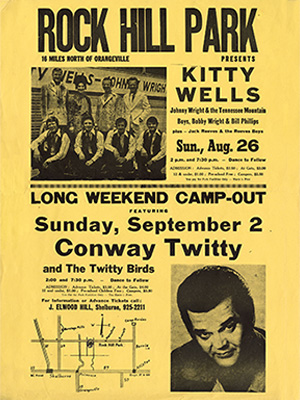
Kitty Wells and Conway Twitty were two of the many country music superstars who played at Rock Hill Park in its heyday. Photo Courtesy Museum of Dufferin Archives.
In the summer of 1963, a Hamilton radio station telephoned Elwood to say Grand Ole Opry star duo Wilma Lee and Stoney Cooper were available to perform on a Saturday night. The event would be in addition to the regular Sunday show and the Hills had only three days to promote and prepare for it. But they did, and the success of this first-ever “Nashville” show was a preview of extraordinary things to come. An enthusiastic crowd of campers ($1.50 per night including the concert) and a paying audience ($1 for adults) sat on lawn chairs and blankets to enjoy the music. They numbered about 600.
Over the years that followed, “Opry” shows on holiday weekends drew crowds in the thousands to Rock Hill Park, attracted by the heavy hitters of country music. When Charley Pride, for example, performed there in July 1979, he had to board a helicopter in Primrose to make his way over the crowd into the park, where he greeted an audience of over 10,000. (The population of the entire township that year was just under 2,000.) That level of enthusiasm for the Rock Hill shows carried on summer after summer. No other rural area in the province could claim anything like it.
The “stars” were truly big stars
The list of performers at these holiday weekend concerts is a who’s who of country music, all of them at the top of their game. Kitty Wells was long established as the Queen of Country Music when she headlined at Rock Hill in 1968 and again in 1977. Webb Pierce performed in 1973, so did Conway Twitty. Ronnie Prophet was featured on Labour Day weekend in 1978 and, on the same weekend the next year, his crowd was outdrawn by Johnny Paycheck. Grandpa Jones from the Hee Haw television show was a regular. Ferlin Husky (1968) had already appeared on The Ed Sullivan Show, while Barbara Mandrell and Willie Nelson, who were frequent headliners in Las Vegas – but always in separate theatres – appeared at Rock Hill in 1980 in the same show!
The high-powered performers were mostly American because that’s the way the system worked, but Elwood always saw to it that Canada’s big names, such as Hank Snow, Wilf Carter and Tommy Hunter, were front and centre, too. That close relationship paid off the time Tommy Hunter volunteered to fill in for Waylon Jennings on a few hours’ notice when, en route to Mulmur, country music’s “outlaw” was denied entry to Canada.
Although weather was an obvious liability for these open-air concerts, it didn’t seem to matter all that much. For the Willie Nelson concert in 1980 (advance tickets $25), Elwood and Jean had prepared elaborately but couldn’t hold off a deluge that delayed the show for hours. Yet the crowd – again over 10,000 – stayed for it and left soaked but happy.
Everything was “down home and personal”
From the beginning, the operation of the campground had set a relaxed tone. Fees were low for this attractive setting on the edge of the Escarpment; it had amenities like a huge spring-fed pond for swimming, playing fields, a pavilion for giant picnics and dances, even a short landing strip. Above all, it had Elwood, Jean and their children (among them, their daughter Mavis, a regular performer at the park and later an Ontario MPP and cabinet minister). Campers could count on personal attention from the family.
The easy tone at the campground carried over into the concerts. In 1964, Elwood and Jean built a stage in the pond for the popular Sunday concerts, and the surrounding natural environment, especially the Escarpment, helped create a kind of homey amphitheatre. To accommodate the thousands at big-name shows on holiday weekends, there were two – sometimes three – larger, moveable stages on the grounds.
The shows, whatever the size, had a Hill family touch. While Jean and the children helped manage ticketing, food and refreshment booths, among other things, Elwood’s amiable and expansive presence was evident at every performance – almost always in a T-shirt and a big white cowboy hat.
Even the bumps in the story are extraordinary
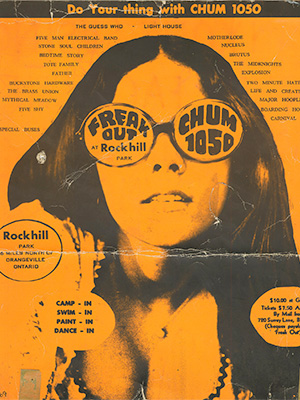
In 1969, the “Freak Out” weekend so alarmed local residents, an injunction was filed to prohibit further rock concerts at the venue. Photo Courtesy Museum of Dufferin Archives.
Inevitably, giant crowds and floods of traffic on country roads, along with noise and litter, tested the tolerance of Rock Hill’s neighbours, not to mention their livestock. Things came to a head in 1969 when Elwood made a musical shift from country music to rock. The “Freak Out” weekend concert that summer, with three performance stages, headlined Lighthouse and The Guess Who, and to the dismay of local residents, brought in thousands of “hippies” for an advertised “camp-in, swim-in, paint-in, dance-in.”
Sponsored by the popular rock station CHUM 1050, the event got extensive, though often uncomplimentary, media attention – the Toronto Star called it a “casually sloppy rural trip” – and this reinforced local uneasiness. However, despite expectations of all kinds of illegal behaviour (75 OPP officers patrolled the site), there was not a single arrest.
Even so, for many residents of Mulmur, the Freak Out was too long and too noisy with an audience far too “alternative.” By the time Elwood mounted repeats in 1970 and ’71, he was facing a lawsuit initiated by the township, resulting in a Supreme Court of Ontario injunction forbidding rock concerts at Rock Hill Park and “any overnight music festival.” It was a major jolt.
On the plus side, the injunction led to a full-scale return to country music at the park, which somehow seemed to restore the enterprise to its natural roots. The following years saw the most notable of the park’s Opry concerts and the Sunday night shows became more popular than ever, staying so to the end.
Not just a park, but a personality
In 1989, Jean Hill told the Shelburne Free Press and Economist that it was her husband’s personality that kept big-name performers coming back to the park. There’s no question that for Rock Hill Park to be the grand venture it became, there had to be a driving force behind it, someone with vision, confidence and energy, prerequisites fully accounted for in Elwood Hill.
With Jean beside him (friends said theirs was a loving and mutually beneficial match), this entrepreneur, promoter, amateur musician – and successful farmer – was as much a phenomenon as his park, so it’s no surprise that when failing health undermined his strength and commitment, the enterprise declined and shut down. 1985 saw the last concert and a year later the park was sold.
It could well be, however, that the spirit that once prevailed on the site is not easily quenched. As recently as 2011, Rock Hill Park was listed on the Ontario Abandoned Places website, but today it’s open once more as a campground and Airbnb called RockHill Park. Elwood and Jean would surely approve.
Booster shots
Many a Canadian musician got a career boost by appearing on a Rock Hill headliner show. Stompin’ Tom Connors, for example, appeared with Hank Snow in 1967. Stompin’ Tom later acknowledged it was one of the first times he carried onto the stage what became his trademark: a piece of plywood for stomping on. Equally notable is the boost afforded young Eilleen Edwards who appeared on the Freddy Fender headliner show in 1977. She was only 11 years old, but the crowd of thousands gave her three standing ovations. A few years later the world would know her as Shania Twain.
Related Stories
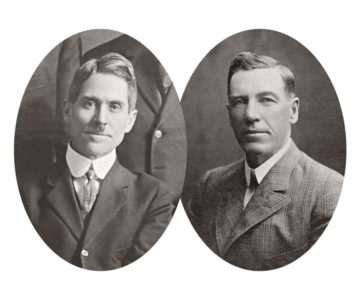
Orangeville’s “Stolen” Election
Mar 29, 2022 | | Historic HillsAngry crowds, a mishandled ballot box, cries of voter suppression and a legal challenge rocked the election for Orangeville’s reeve in 1909.
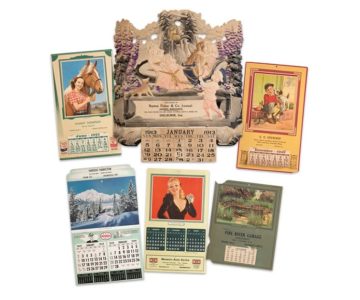
Free Calendars at Christmas
Nov 29, 2021 | | Historic HillsCollecting calendars was once a seasonal ritual on main street.
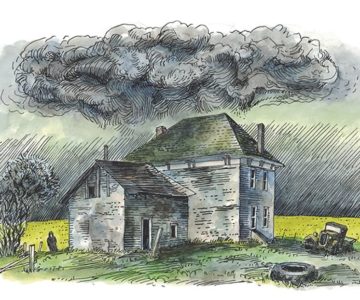
‘Spooks’ In the Hills
Sep 24, 2021 | | Historic HillsIn 1930, a series of strange physical disturbances led a family to abandon their farm in Mulmur Township. Was a spirit at work? A poltergeist? Was it real?
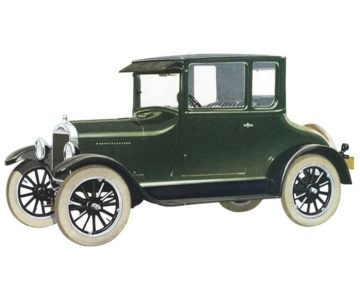
The Auto Takes Hold
Jun 22, 2021 | | Historic HillsIn less than two decades automobiles grew from curiosity to commonplace in these hills.








